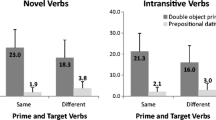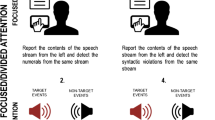Abstract
Three experiments were conducted to investigate the relative timing of syntactic and pragmatic anomaly detection during sentence processing. Experiment 1 was an eye movement study. Experiment 2 employed a dual-task paradigm with compressed speech input, to put the processing routines under time pressure. Experiment 3 used compressed speech input in an anomaly monitoring task. The outcomes of these experiments suggest that there is little or no delay in pragmatic processing relative to syntactic processing in the comprehension of unambiguous sentences. This narrows the possible explanations for any delays that are observed in the use of pragmatic information for ambiguity resolution.
Similar content being viewed by others
References
Altmann, G. T. M. (1988). Ambiguity, parsing strategies, and computational models.Language and Cognitive Processes, 3, 73–97.
Altmann, G. T. M., & Young, D. (1993). Factors affecting adaptation to time-compressed speech.Proceedings of Eurospeech, 93.
Bates, E., & MacWhinney, B. (1989).Functionalism and the competition model. Cambridge, England: Cambridge University Press.
Boland, J. E. (1996). The relationship between syntactic and semantic processes in sentence comprehension. Manuscript submitted for publication.
Boland, J. E., Tanenhaus, M. K., & Garnsey, S. (1990). Evidence for the immediate use of verb control information in sentence processing.Journal of Memory and Language, 29, 413–432.
Boland, J. E., Tanenhaus, M. K., Garnsey, S., & Carlson, G. (1995).Journal of Memory and Language, 34, 774–806.
Carlson, G. N., & Tanenhaus, M. K. (1988). Thematic roles and language comprehension. In W. Wilkins (Ed.),Syntax and semantics, Vol. 1: Thematic Relations. London: Academic Press.
Chodorow, M. S. (1979). Time-compressed speech and the study of lexical and syntactic processing. In: W. E. Cooper & E. C. T. Walker (Eds.),Sentence processing: Psycholinguistic studies presented to Merrill Garrett. Hillsdale, NJ: Erlbaum.
Chomsky, N. (1981).Lectures on government and binding. Dordrecht, The Netherlands: Foris.
Crain, S., & Steedman, M. (1985). On not being led up the garden path: The use of context by the psychological parser. In D. R. Dowry, L. Karttunen, & A. M. Zwicky (Eds.),Natural language parsing: Psychological, computational, and theoretical perspectives. Cambridge, England: Cambridge University Press.
Ferreira, F., & Clifton, C. (1986). The independence of syntactic processing.Journal of Memory and Language, 25, 348–368.
Fodor, J. A. (1983).Modularity of mind. Cambridge, MA: MIT Press.
Fodor, J. D., & Inoue, A. (1994). The diagnosis and cure of garden paths.Journal of Psycholinguistic Research, 23, 407–434.
Francis, W. N., & Kucera, H. (1982).Frequency analysis of English usage. Boston: Houghton Mifflin Company.
Frazier, L. (1990). Exploring the architecture of the language-processing system. In G. T. M. Altmann (Ed.),Cognitive models of speech processing: Psycholinguistic and computational perspectives. Cambridge, MA: MIT Press.
Friederici, A. D., Mecklinger, A., Steinhauer, K., & Hahne, A. (1995, March).Processing violations of syntactic structure versus violations of syntactic preference: Evidence from ERP studies. Paper presented at the 8th CUNY Conference on Human Sentence Processing, Tucson.
Gorrell, P. (1989). Establishing the loci of serial and parallel effects in sentence processing.Journal of Psycholinguistic Research, 18, 61–73.
MacDonald, M. C. (1994). Probabilistic constraints and syntactic ambiguity resolution.Language and Cognitive Processes, 32, 692–715.
McClelland, J. L., St. John, M., & Taraban, R. (1989). Sentence comprehension: A parallel distributed processing approach.Language and Cognitive Processes, 4, 287–336.
McElree, B., & Griffith, T. (1995). Syntactic and thematic processing in sentence comprehension: Evidence for a temporal dissociation.Journal of Experimental Psychology: Learning, Memory and Cognition, 21, 134–157.
Meltzer, S. G. (1995).Issues in the processing of null subjects. Unpublished doctoral dissertation, City University of New York.
Mitchell, D. C., Corley, M. M. B., & Garnham, A. (1992). Effects of context in human sentence parsing: Evidence against a discourse-based proposal mechanism.Journal of Experimental Psychology: Learning, Memory and Cognition, 18, 69–88.
Ni, W., Crain, S., & Shankweiler, D. (in press). Sidestepping garden paths. Assessing the contribution of syntax, semantics and plausibility in resolving ambiguities.Language and Cognitive Processes.
Ni, W., Fodor, J. D., Crain, S., & Shankweiler, D. (1996). Anomaly detection: Eye movement patterns. Haskins Laboratories. Manuscript submitted for publication.
Ni, W., Fodor, J. D., Crain, S., Shankweiler, D., & Mattingly, I. G. (1993, March).Evidence of the autonomy of syntax and pragmatics. Poster presented at the 6th Annual CUNY Sentence Processing Conference, University of Massachusetts, Amherst.
Osterhout, L., & Holcombe, P. J. (1992). Event-related brain potentials elicited by syntactic anomaly.Journal of Memory and Language, 31, 785–806.
Osterhout, L., Nicol, J., McKinnon, R., Ni, W., Fodor, J. D., & Crain, S. (1994, March).An event-related brain potential investigation of the temporal course of sentence comprehension. Poster presented at the 7th Annual CUNY Sentence Processing Conference, City University of New York.
Pearlmutter, N. J., Garnsey, S. M., & Bock, K. J. (1995, March).Subject-verb agreement processes in sentence comprehension. Paper presented at the 8th CUNY Conference on Human Sentence Processing, Tucson.
Rayner, K., Carlson, M., & Frazier, L. (1983). The interaction between syntax and semantics during sentence processing: Eye movements in the analysis of semantically biased sentences.Journal of Verbal Learning and Verbal Behavior, 22, 358–374.
Shapiro, L., Zurif, E., & Grimshaw, J. (1987). Sentence processing and the mental representation of verbs.Cognition, 27, 219–246.
Swinney, D., & Osterhout, L. (1989). Inference generation during auditory language comprehension. In A. Graesser & G. H. Bower (Eds.),The psychology of learning and motivation. Academic Press.
Tanenhaus, M. K., Garnsey, S. M., & Boland, J. E. (1990). Combinatory lexical information and language comprehension. In G. T. M. Altmann (Ed.),Cognitive models of speech processing: Psycholinguistic and computational perspectives. Cambridge, MA: MIT Press.
Tanenhaus, M. K., & Trueswell, J. C. (1994). Sentence comprehension. In J. Miller & E. Eimas (Eds.),Handbook of Perception and Cognition: Volume II: Speech, Language, and Communication.
Trueswell, J. C., Tanenhaus, M. K., & Garnsey, S. M. (1994). Semantic influences on parsing: Use of thematic role information in syntactic ambiguity resolution.Journal of Memory and Language, 33, 285–318.
Urbach, T., Pickering, M., Branigan, H., & Myler, L. A. (1995, March).Event-related potential effects and parsing. Poster presented at the 8th CUNY Conference on Human Sentence Processing, Tucson.
Young, D., Altmann, G. T. M., Cutler, A., & Norris, D. (1993). Metrical structure and the perception of time-compressed speech.Proceedings of Eurospeech, 93.
Author information
Authors and Affiliations
Additional information
The research reported in this paper was supported by Program Project Grant HD-01994 to Haskins Laboratories from the National Institutes of Child and Human Development, and in part by a grant to Stephen Crain and Donald Shankweiler from the University of Connecticut Research Foundation. We thank Jacques Mehler and Gerry Altmann for helpful information about speech compression algorithms. We are especially grateful to Ignatius Mattingly for his generous expert advice on speech compression and design of the experimental materials, and also for recording all the speech stimuli. Julie Boland, Brian McElree, Janet Nicol, and Martin Pickering provided very helpful advice on an earlier draft.
Rights and permissions
About this article
Cite this article
Fodor, J.D., Ni, W., Crain, S. et al. Tasks and timing in the perception of linguistic anomaly. J Psycholinguist Res 25, 25–57 (1996). https://doi.org/10.1007/BF01708419
Issue Date:
DOI: https://doi.org/10.1007/BF01708419




